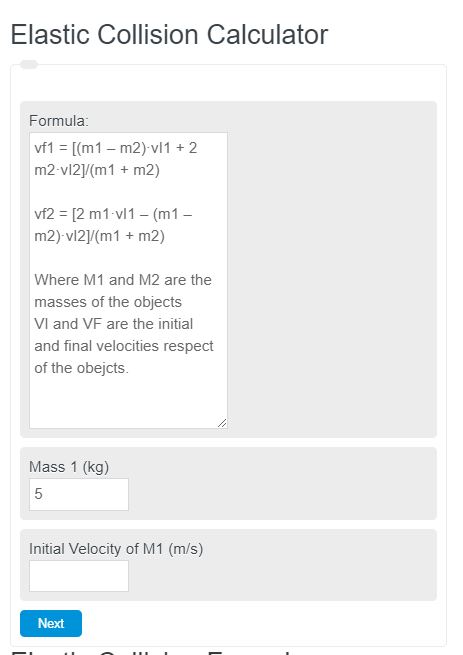Enter the mass and initial velocity of two different objects undergoing an elastic collision. The calculator will calculate the final velocities of each object and the total kinetic energy. This calculator can evaluate any of the elastic collision values if the other variables are known.
- Conservation of Momentum Calculator
- Elastic Potential Energy Calculator
- Horizontal Projectile Motion Calculator
- Elasticity Calculator (Physics)
- Bump Load Calculator
Elastic Collision Formula
The following formula is used to calculate the velocities of two objects after an elastic collision.
m1·vi1 + m2·vi2 = m1·vf1 + m2·vf2
vf1 = [(m1 - m2)·vI1 + 2 m2·vI2]/(m1 + m2)
vf2 = [2 m1·vI1 - (m1 - m2)·vI2]/(m1 + m2)
- Where M1 and M2 are the masses of the objects
- VI and VF are the initial and final velocities with respect to the objects.
The first formula above is derived from the law of conservation of momentum. We can derive these formulas because elastic collisions conserve energy and therefore conserve momentum.
Elastic Collision Definition
An elastic collision is the collision of two or more objects which act perfectly elastic, and as a result, momentum and energy are both conserved.
How to calculate an elastic collision?
How to calculate an elastic collision
- First, determine the masses of each object
Measure the masses of objects 1 and 2 using an accurate scale or formula.
- Next, measure the initial velocities of each object
Using a speed radar or another formula, calculate the initial velocities of the object.
- Calculate the final velocities
Using the two formulas above, and then the information measured in steps 1 and 2, calculate the final velocities of the objects after an elastic collision.
FAQ
An elastic collision is a collision of 2 or more objects in which the object reacts perfectly elastically. This means that conservation of momentum and energy are both conserved before and after the collision.

